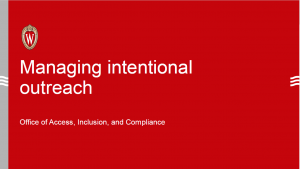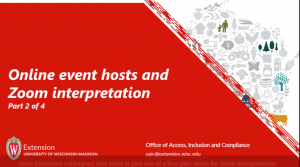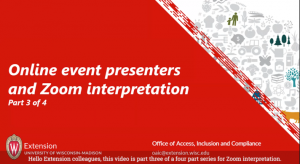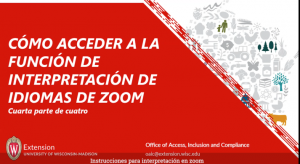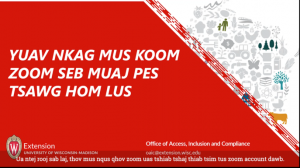Civil Rights Requirements
Training for Area Educators
Title: Foundations of Equitable Program Development Series

Description
The Foundations of Equitable Program Development series provides Extension Area teams and statewide project teams with tools to understand demographics in their services areas. It also focuses on applying those tools and other processes to be intentional in their outreach and relationship-building efforts. Colleagues will learn how to use the Equitable Program Development Dashboard to understand key demographic variables, explore tools for sense-making of qualitative data, and collaboratively identify gaps in services.
Structure
The series consists of four modules divided into nine facilitated sessions. Each module consists of facilitated virtual-learning sessions, individual online-learning activities, and large-group application and debriefing activities.
Learning objectives
Area colleagues and project teams, including administrative staff, will develop a shared understanding of:
- who in their community(ies) is served and underserved by your program(s)
- what assets are available for building and deepening relationships with groups who are underserved by Extension
- next steps for collaboratively advancing relationship building efforts
How to register
To register your Area or Project Team for this series, please complete an OAIC Service Request Form. Select “I want to enroll my Area or Project Team in the Foundations of Equitable Program Development series”. OAIC will respond as soon as possible to arrange a consultation session with you and the OAIC team.
For additional information, please contact teresa.curtis@wisc.edu
ADA & Accessibility
Inclusive Practices Through a Disability Lens
by Heather Stelljes, MS, Access Consultant
Learning Objectives:
- Explore the definition and demographics of disability
- Apply different models of disability to the formal accommodation request process
- Examine principles of Universal Design of Learning and how they inform inclusive program planning
Web and Document Accessibility for Virtual Programming
Heather Stelljes and Keven Graeme
Kevin Graeme of Educational Technology Support and Heather Stelljes of Office of Access, Inclusion, and Compliance join forces to share information on creating accessible and inclusive document and web programming for participants with disabilities. Being thoughtful about disability access is a practice that benefits all users, learners, and participants, while also being a hard-fought federal mandate for the Division of Extension. In this breakout, we’ll cover the legal mandates for disability accommodations and accessibility by sharing broad information on apparent and non-apparent disabilities. We’ll share examples of inclusive practices in the virtual environment and demonstrate how to ensure accessibility. Additional resources to create online and document accessibility will also be shared.
Ready to dig in? Culturally Responsive Programming PowerPoint
More information on disability accommodations can be found here.
The Zoom can be found at this link.
Relationship Development & Strengthening
Linguistically Inclusive Programming
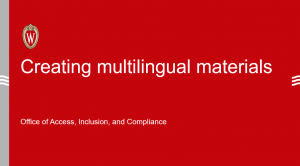
Creating multilingual materials
This presentation shows a step-by-step process to creating multilingual outreach materials for LEP audiences
Organizing & Facilitating Multilingual Zoom Meetings/Cómo organizar y manejar las reuniones multilingües en Zoom
Carlos Miranda, Victoria Solomon, Diana Hammer
In this session, we will teach best practices for hosting a Zoom meeting using interpretation. We will discuss:
- What to do ahead of time to prepare logistically
- What to do during the meeting to make sure it is a smooth experience for participants
- How to interact most positively with the interpreters so they can do their best work
We will also demonstrate Zoom interpretation for a few minutes so you can get a feel for the participants’ view of it.
NOTE: We are asking that participants be prepared to use two separate devices during a portion of the presentation.
Culturally Responsive Practices

Learning Objectives:
- Frame what our educators should know about their localized context
- Apply the theoretical foundations of Culturally Responsive Practices (CRP) to Extension’s educational programs and products
- Examine samples of CRP within the context of their strengths and limitations
Ready to dig in? Culturally Responsive Programming PowerPoint
Culturally Responsive Practices Handout
The Zoom can be found at this link
Additional Resources:
- The National Academies Press – free PDF downloads available, recommended by Dr. Gloria Ladson-Billings
- “They All Saw a Cat” by Brendan Wenzel, recommended by our colleague Rachel Skoczek to illustrate positionality
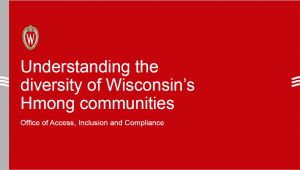
Understanding the diversity in Wisconsin’s HMoob communities and a foundation for building partnerships
Ariana Thao
- Understand the diversity of HMoob communities
- Build skills to connect with HMoob communities
- Expand access to HMoob communities
Learning about OAIC
OAIC Intake: So, what do you know?
Rick Mills
Overview of new OAIC website and location of guidance materials & resources. Become aware of services offered by OAIC and become more familiar with the OAIC service request intake process.
Click here to access the video
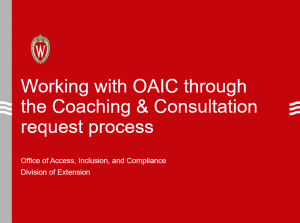
Working with OAIC through the Coaching & Consultation request process
This presentation shares an overview of the Coaching & Consultation process, the role of requesters, and the role of OAIC.
Expanding Access: The Critical Role of Administrative Support Staff
Administrative support staff play a crucial role in Extension offices across the state, including efforts to expand access to underrepresented and underserved communities. In this session, facilitated by the Office of Access, Inclusion, and Compliance (OAIC), attendees will learn how administrative staff can partner with OAIC in key functions such as planning, marketing, and outreach strategies. Attendees will also build skills for ensuring language access and communicative equity. Finally, we will explore best practices in maintaining office civil rights documentation.
Zoom interpretation video series
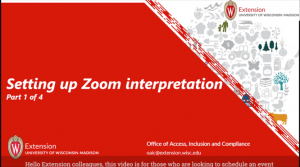
Setting up Zoom interpretation
This video is part one of a four part series on Zoom interpretation. This video explains to colleagues how to set up Zoom interpretation.
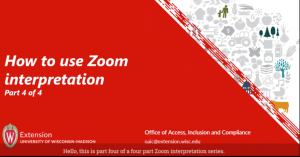
How to use Zoom interpretation
This video is part four of a four part series on Zoom interpretation. This video explains to participants on how they can use the Zoom interpretation feature at their online event.
